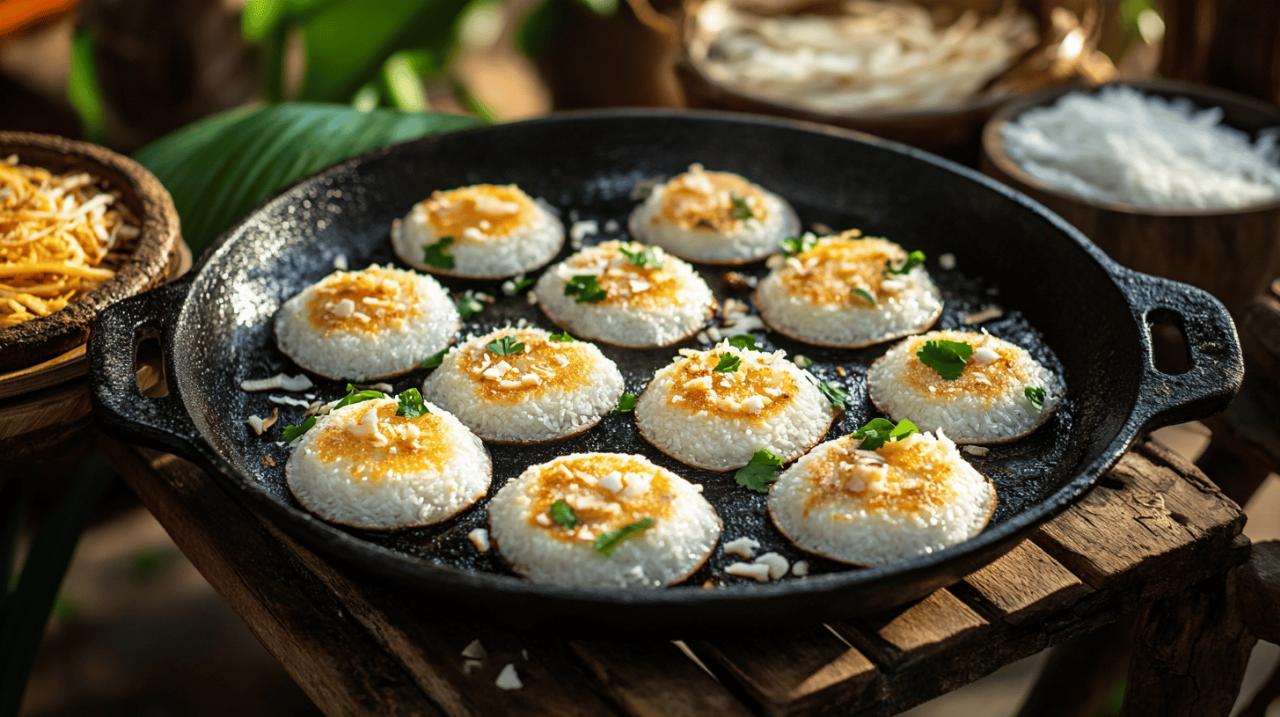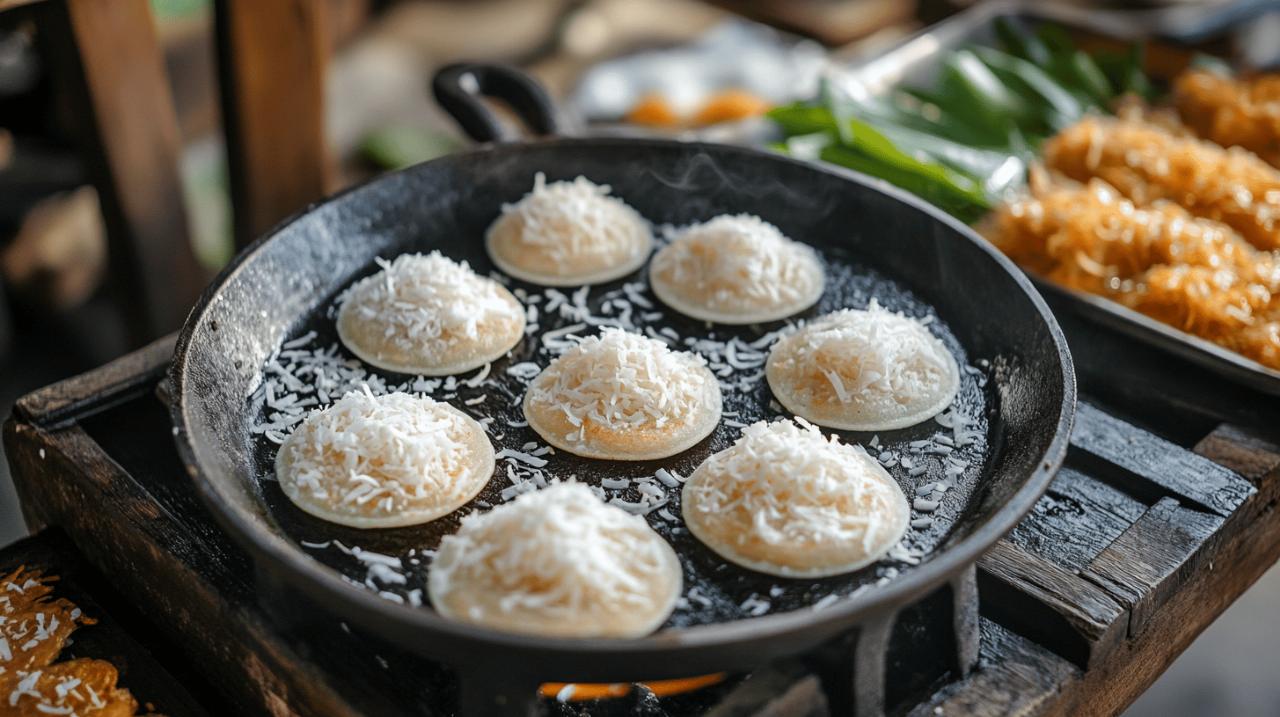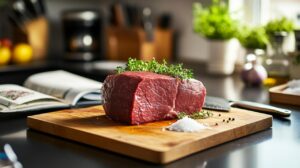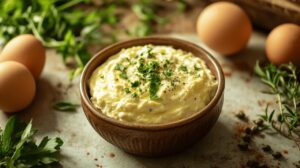Creamy Coconut Techniques: Recette Facile de Kanom Krok for Perfectly Balanced Thai Pancakes
Kanom Krok, the beloved Thai coconut pancake, is a street food delicacy that captures the essence of Thai cuisine in miniature form. These small, circular treats offer a delightful contrast of textures and flavours that has made them a staple in Thailand and increasingly popular worldwide. With their crispy bottoms and creamy centres, these little pancakes provide a perfect bite-sized introduction to the complex flavour profiles that Thai cuisine is known for.
The magic of thai coconut pancakes
Origins and Cultural Significance of Kanom Krok
Deeply embedded in Thai food culture, Kanom Krok has been enjoyed on the streets of Thailand for generations. These small pancakes represent the beautiful simplicity of Thai street food, where minimal ingredients transform into something extraordinary through traditional techniques. Street vendors across Thailand have been perfecting these coconut delights for decades, creating a dish that connects people to their culinary heritage. Many Thai families have their own special recipes, passed down through generations. Some vendors, like Amy Raaf's grandmother, made their living selling these treats at local markets, where they would become beloved figures in their communities.
What makes these treats so special
The true magic of Kanom Krok lies in its contrasting textures. When properly prepared, each pancake features a satisfyingly crispy golden bottom that gives way to a creamy, custard-like middle. This textural interplay makes each bite a sensory experience. The main flavour profile revolves around coconut milk, which provides a rich sweetness balanced by a touch of salt. Unlike many Western pancakes, Kanom Krok is naturally gluten-free, dairy-free, and egg-free, making them accessible to those with various dietary restrictions. Their small size also makes them perfect for sharing or enjoying as a quick snack alongside other Thai dishes.
Essential ingredients and preparation
Gathering your kanom krok components
To create authentic Thai Coconut Pancakes at home, you'll need to gather specific ingredients that form the foundation of this treat. The shell batter typically requires rice flour, jasmine rice, coconut milk, shredded dried coconut, palm sugar, and salt. For the filling, you'll need additional coconut milk, granulated sugar, salt, and a bit more rice flour to achieve the proper consistency. Most recipes call for approximately 400 grams of rice flour, 3 cups of coconut milk, 2 tablespoons of granulated sugar, and 2 teaspoons of salt for the batter base. The creamy filling usually consists of 2 cups of coconut cream, three-quarters cup of granulated sugar, a teaspoon of salt, and one and a half tablespoons of rice flour. Some recipes incorporate sparkling mineral water to add lightness to the batter, creating that perfect texture contrast between crispy and creamy.
Creating the perfect batter consistency
The secret to successful Kanom Krok lies in achieving the right batter consistency for both the shell and the filling. The shell batter should be thin enough to spread across the pan but thick enough to form a stable base. To prepare it properly, combine the rice flour, coconut milk, sugar, and salt, whisking until completely smooth with no lumps. The filling mixture requires a similar approach but with a higher proportion of coconut cream to create that signature velvety middle. Many Thai cooks recommend allowing the batter to rest for at least 10-15 minutes before cooking, giving the rice flour time to hydrate fully and the flavours to meld together. This resting period also helps achieve that essential textural contrast that defines these pancakes. Take care not to overmix, as this can make the pancakes tough rather than tender.
Mastering the cooking process
Selecting and Using the Right Pan
The distinctive shape of Kanom Krok comes from a special pan with round indentations. Traditional cooks use a dedicated Kanom Krok pan made of cast iron, but home cooks can substitute with an Ebelskiver pan or takoyaki pan with similar half-sphere moulds. These speciality pans allow the pancakes to develop their characteristic dome shape and crispy bottom. Before cooking, the pan must be properly heated to approximately 325°F or 160°C. Each indentation should be lightly greased with vegetable oil to prevent sticking and to help achieve that golden-brown exterior. The proper heat level is crucial for success with these pancakes, as too high heat will burn the bottoms before the filling sets, while too low heat will result in soggy pancakes lacking the signature crispy texture.
Achieving the Ideal Dome Shape and Texture
The cooking technique for Kanom Krok requires attention to detail and timing. Start by pouring the shell batter into the heated, oiled indentations, allowing it to coat the sides. After a minute or so, add a small amount of the filling mixture to the centre of each pancake. Watch for small bubbles to form around the edges, which indicate that the pancakes are cooking properly. The pancakes need approximately 5 minutes of cooking time until the bottoms turn golden brown and crispy, while the tops set but maintain their creamy consistency. Resist the temptation to add too much filling, as this can prevent proper cooking and result in runny centres. The finished pancakes should be slightly domed with a firm bottom and a creamy but set centre that holds its shape when removed from the pan.
Serving suggestions and flavour combinations
Traditional toppings and variations
While Kanom Krok is delicious on its own, traditional toppings add extra dimensions of flavour and texture. Common additions include chopped green onions, cooked sweet corn kernels, and shredded fresh coconut. Some variations incorporate cooked taro cubes for a starchy contrast to the creamy filling. Each topping should be added just after pouring the filling, allowing it to cook slightly into the surface. Regional variations exist throughout Thailand, with some areas favouring sweeter versions while others lean toward more savoury interpretations. Modern adaptations might include chocolate chips, fruit preserves, or even savoury options like minced meat or seafood. These toppings should be used sparingly to maintain the balance of the pancake and not overwhelm its delicate coconut flavour.
Pairing Ideas for a Complete Thai Experience
Kanom Krok is typically enjoyed as a snack or light meal, but can be incorporated into a larger Thai dining experience. They pair wonderfully with Thai iced tea or coffee, creating a perfect afternoon treat. For a more substantial offering, serve these coconut pancakes alongside other Thai street food favourites like satay skewers or som tam (green papaya salad). The contrast between the sweet, creamy pancakes and spicy, savoury dishes creates a balanced meal that showcases the diversity of Thai cuisine. These pancakes are best enjoyed fresh and warm, as they tend not to keep well due to their contrasting textures. With approximately 68 calories per pancake, they make a relatively light indulgence that can be enjoyed as part of a health-conscious meal plan. Whether served as a starter, dessert, or standalone snack, Kanom Krok offers a taste of authentic Thai street food culture right in your home.
Nutritional benefits and dietary considerations
Kanom Krok, those delightful Thai coconut pancakes with their distinctive crispy bottom and creamy middle, aren't just a taste sensation – they also offer some interesting nutritional aspects worth exploring. With approximately 68 calories per pancake, these bite-sized treats can be enjoyed as part of a balanced diet. The traditional recipe relies on natural ingredients like coconut milk, rice flour, and palm sugar, making them suitable for many dietary requirements.
Gluten-free and dairy-free adaptations
One of the brilliant aspects of Kanom Krok is that they're naturally gluten-free and dairy-free, making them accessible to many with dietary restrictions. The authentic recipe uses rice flour rather than wheat flour, which is perfect for those avoiding gluten. The creamy texture comes from coconut milk rather than dairy, creating that luscious mouthfeel without any animal products. This makes Kanom Krok an excellent choice for those with coeliac disease or lactose intolerance. The absence of eggs in traditional recipes also makes them suitable for those with egg allergies or following a vegan lifestyle. As Kayla noted in her comment about the recipe, she was particularly excited to try these pancakes specifically because they contain no eggs, gluten or dairy.
Balancing Flavour and Nutrition in Your Kanom Krok
While Kanom Krok are a treat, there are ways to boost their nutritional profile. The traditional shell batter combines jasmine rice, rice flour and coconut milk, providing some carbohydrates and healthy fats. With about 13g of carbs, 2g of fat and 1g of protein per pancake, they offer a quick energy boost. The toppings present an opportunity to add nutritional value – consider the traditional options of sweet corn for added fibre, green onions for vitamins and minerals, or shredded coconut for texture. You might also experiment with cooked taro cubes for additional nutrients. The filling typically includes coconut milk, sugar, salt and rice flour – try reducing the sugar slightly for a less sweet version. When cooking your Kanom Krok, be mindful of the amount of oil used in the pan, as this can affect the overall fat content. Remember that these pancakes are best enjoyed fresh and warm when their signature contrast between crispy exterior and creamy centre is at its peak.










